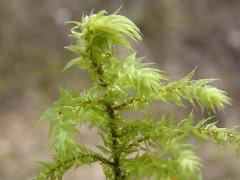 |
| Photo: Micheal Succow |
Sphagnum turns to peat as it decomposes. Sphagnum moss, the live portion of the plant, is sold packaged in whole pieces, dried or fresh, and is most often used to line wire hanging baskets and other types of containers.
Sphagnum peat, a natural, organic soil conditioner used to regulate moisture and air around plant roots, is being over-harvested and is also being harvested in ways that render a peat bog or fen completely unsustainable. This is alarming not only because of the specter of species or bog extinction, but because peatlands are huge carbon sinks, and when they are drained and harvested at an accelerated rate, methane, a greenhouse gas, is released.
(Read more for videos and .pdfs on peatland ecology, plus a list of terms and definitions.)
Fortunately, many scientific studies are focusing on regeneration of various Sphagnum species in the hope of restoring or reclaiming lost peatlands. There are international organizations dedicated to the restoration of bogs that have been completely drained and harvested. Unfortunately, little of the plant regenerates at the rate it is being used. You can make a difference by asking your florist and nursery to use sustainably harvested peat or moss.
To view videos and read about efforts to restore peatland ecology, visit Peat Moss and the Environment.
- Definitions, characteristics, uses, environmental issues - by the Canadian Sphagnum Peat Moss Association (8 pages)
- Wise Use of Peatlands video (19 minutes)
- YouTube "For Peat's Sake - Bogs and Climate Change" (1:30, below)
Terms and definitions (from the Canadian Sphagnum Peat Moss Association):
- Peat - The largely organic residues of plants, incompletely decomposed through lack of oxygen.
- Peat moss or moss peat - Partially decayed mosses including:
- Sphagnum peat - Peat that is composed mainly of partially decomposed Sphagnum moss species. Commonly called peat moss or sphagnum peat moss. This is the most important type of peat for horticultural use.
- Hypnum peat- Peat that is composed mainly of stems and leaves from various Hypnum moss species.
- Peat humus - Peat that is fully decomposed so that none of the original plants can be identified.
- Sphagnum moss - A group of mosses that grow in bogs. In horticulture, sphagnum moss refers to the live portion of the plant that is available packaged in whole pieces, dried or fresh. It is often confused with sphagnum peat moss. Sphagnum moss is most often used to line wire hanging baskets and other types of containers. It is not used as a soil amendment.
- Wetland - A broad term that is used to describe areas which are waterlogged all or most of the time.
- Peatland - A specific type of wetland on which extensive organic material has accumulated. These areas with peat-forming vegetation growing on peat have an undrained layer of peat at least 12-18 inches deep. Peatlands are found in all parts of the world except deserts and arctic regions.
- Bog - Peatland with the water table at or near the surface. The types of plants growing in a bog tend to be limited in diversity because of the acid, nutrient-poor environment. Plants found growing in a bog obtain nutrients primarily from rainfall.
- Fen - Peatland with the water table usually at or just above the surface. Plants obtain nutrients from soil and groundwater.
- Reclamation - Ways of using peatlands after they have been harvested. Reclaimed peatlands are commonly changed into natural areas and wildlife habitats that are ecologically different from the original site, converted into forestry plantations, or developed as agricultural cropland.
- Restoration - Reestablishment of a harvested site as a peatland with characteristics nearly identical to pre-harvesting conditions



